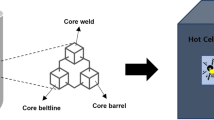Abstract
Airborne particles of nuclear fuel from the Chernobyl reactor that had been collected on air filters and stored, were characterised using in vitro dissolution tests to assess effective doses after their inhalation. As solvent, the Gamble biological fluid was used to simulate lung fluid. The solubility of the measured radionuclides decreased in the order 137Cs>90Sr>>241Am≥239+240Pu in the simulated lung fluid. The dissolution rate constant of e.g. 239+249Pu ranged from 0.72 to 5.4×10−6 g·cm−2 d−1 and decreased (for all nuclides) with increasing particle size as predicted from theoretical considerations. Considering the inhalation dose, decreasing dose with size and increasing doses with lower solubility may partly counterbalance each other for 137Cs and 90Sr. On the other hand, for 239Pu and 241Am larger particles and associated lower solubility both change the resulting dose in the same direction towards lower values. The comparison of the experimentally determined dose coefficients with ICRP values indicates that nuclear fuel particles closely resemble type M material characteristics for 137Cs and 90Sr and type S material characteristics for 239Pu and 241Am.



Similar content being viewed by others
References
Ermilov AP, Ziborov AM (1993) Radionuclide relations in the fuel component of the radioactive fallout in the near Chernobyl NPP (in Russian). Radiat Risk 3:134–138
Dubasov YuV, Savonenkov VG, Smirnova EA (1996) Systematisation of radioactivity products of the accident at the Chernobyl NPP (in Russian). Radiochemistry 38:101–116
Cuddihy RG, Finch GL, Hahn FF, Mewhinney JA, Rothenberg SJ, Powers DA (1989) Characteristics of radioactive particles released from the Chernobyl nuclear reactor. Environ Sci Technol 23:89–95
Bogatov CA, Borovoi AA, Dubasov YuV, Lomonosov VV (1990) Shape and characteristics of particles of the fuel emission during the accident at the Chernobyl NPP (in Russian). Atomic Energy 69:36–40
Kutkov VA, Kamarinskaya OI (1996) In vitro solubility of Chernobyl nuclear fuel aerosol with respect to collective behaviour of its radionuclides. IRPA 9 International Congress on Radiation Protection, Vienna, April 1996, 2:445–447
Garger EK, Kashpur V, Belov G, Demchuk V, Tschiersch J, Wagenpfeil F, Paretzke HG, Besnus F, Holländer W, Martinez-Serrano J, Vintersved I (1997) Measurement of resuspended aerosol in the Chernobyl area. Part I. Discussion of instrumentation and estimation of measurement uncertainty. Radiat Environ Biophys 36:139–148
Mercer TT (1967) On the role of particle size in the dissolution of lung burdens. Health Phys 13:1211–1221
Garger EK, Kashpur V, Paretzke HG, Tschiersch J (1998) Measurement of resuspended aerosol in the Chernobyl area. Part II. Size distribution of radioactive particles. Radiat Environ Biophys 36:275–283
Petryanov IV, Kozlov VI, Basmanov PI, Ogorodnikov BI (1968) Fibrous filtering material FP (in Russian). Moscow Knowledge, Moscow
Wagenpfeil F, Tschiersch J (2001) Resuspension of coarse fuel hot particles in the Chernobyl area. J Environ Radioact 52:5–16
Ansoborlo E, Hengé-Napoli MH, Chazel V, Gibert R, Guilmette RA (1999) Review and critical analysis of available in vitro dissolution tests. Health Phys 77:638–645
Eidson AF, Griffith WC (1984) Techniques for yellow cake dissolution studies in vitro and their use in bioassay interpretation. Health Phys 46:151–163
Miglio JJ, Muggenburg BA, Brooks AL (1977) A rapid method for determining the relative solubility of plutonium aerosols. Health Phys 33:449–457
Gamble JL (1967) Chemical anatomy, physiology and pathology of extracellular fluid. Harvard University Press, Boston, pp 4–11
Eidson AF, Mewhinney JA (1983) In vitro dissolution of respirable aerosols of industrial uranium and plutonium mixed-oxide nuclear fuels. Health Phys 45:1023–1037
Dennis NA, Blauer HM, Kent JE (1982) Dissolution fractions and half-times of single source yellowcake in simulated lung fluids. Health Phys 42:469–477
Ansoborlo E, Guilmette RA, Hoover MD, Chazel V, Houpert P, Hengé-Napoli MH (1998) Application of in vitro dissolution tests to different uranium compounds and comparison with in vivo data. Radiat Prot Dosim 79:33–37
Ageyev VA, Odintsov OO, Sajeniouk AD (2003) The rapid radiochemical method for determination of 238Pu, 239+240Pu, 241Am and 244Cm in the aerosol filter by ion-exchange chromatography. In: Proceedings of the Sixth International Conference on Methods and Application of Radioanalytical Chemistry (MARC VI). April 7–11, 2003, Kailua-Kona, Hawaii, USA, pp 64–65
Ageyev VA, Vyrichek SL, Kluchnikov AA, Lashko AP, Levshin EB, Odintsov AA, Lashko TN (1998) Evaluation of 242mAm contents in the fuel of unit 4 of Chernobyl NPP (in Russian). Atomic Energy 84:340–344
Birchall A, Puncher M, James AC, Marsh JW, Jarvis NS, Peace MS, Davies K, King DJ (2003) IMBA-EXPERT™: Internal dosimetry made simple. Radiat Prot Dosim 105:421–424
ICRP (1994) Publication 66. Human respiratory tract model for radiological protection. Annals of the ICRP 24. Pergamon Press, Oxford
ICRP (1990) Publication 56. Age-dependent doses to members of the public from intake of radionuclides: Part 1. Annals of the ICRP 20. Pergamon Press, Oxford
ICRP (1993) Publication 67. Age-dependent doses to members of the public from intake of radionuclides: Part 2. Annals of the ICRP 23. Pergamon Press, Oxford
ICRP (1983) Publication 38. Radionuclide transformations: Energy and intensity of emissions. Annals of the ICRP 11–13. Pergamon Press, Oxford
Acknowledgement
This study was supported by the Bundesminister für Umwelt, Naturschutz und Reaktorsicherheit under contract StSch 4232. Its contents are solely the responsibility of the authors.
Author information
Authors and Affiliations
Corresponding author
Rights and permissions
About this article
Cite this article
Garger, E.K., Sazhenyuk, A.D., Odintzov, A.A. et al. Solubility of airborne radioactive fuel particles from the Chernobyl reactor and implication to dose. Radiat Environ Biophys 43, 43–49 (2004). https://doi.org/10.1007/s00411-004-0226-y
Received:
Accepted:
Published:
Issue Date:
DOI: https://doi.org/10.1007/s00411-004-0226-y




